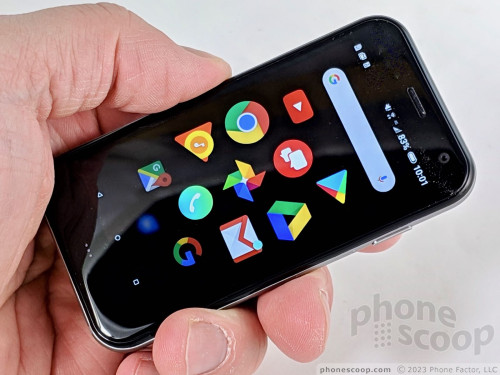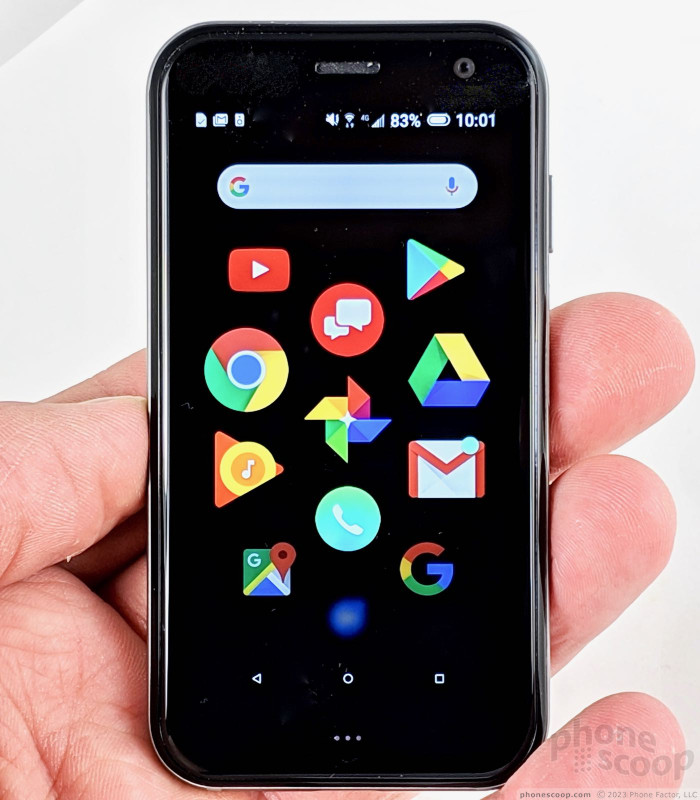Review: Palm Phone for Verizon Wireless
Nov 9, 2018, 12:00 PM by Eric M. Zeman

A California startup hopes a bit of nostalgia for one of the pioneers in the smartphone space will drive sales of its new device, the Palm Phone. Verizon sells this tiny telephone as an accessory for your main device. Is it worth paying for two phones so you can put your main device down on the weekends? Find out in Phone Scoop's in-depth review.
Is It Your Type?
The Palm phone is an accessory, not a primary device. It's for people who want to curb their smartphone addiction on weekends, vacations, etc., without completely disconnecting. It offers most of the features of a full-fledged smartphone in a form factor the size of credit card.

Preamble
This Palm is not the Palm of old. The old Palm died, wholly and utterly, crushed by Apple and Google. It was bought by HP, kept afloat for about a year, and later sold off in pieces. WebOS went to LG, while the Palm brand hopped over to TCL, and later to a totally different California startup called, believe it or not, Palm.
The new Palm's vision is to "bring people out of their tech and into their lives." The company hopes you'll put your main device down and instead carry around the diminutive Palm, which quite intentionally does less.
Does it succeed in that goal? Sort of.
Body
When I showed the Palm phone to my daughter she promptly lost her mind. She snatched it from my hand and jumped up and down excitedly shrieking about how cute it is. This lasted for nearly 10 minutes. She asked if it was a small version of the iPhone X. I can see why she'd think so. She immediately wanted to know if should could use it instead of her larger phone. The answer to that is no, but not because I'm a mean dad. There's no doubt the Palm phone appeals to someone, even if that someone is perhaps younger than the intended market.
The one thing that stands out most about the Palm is just how tiny it is. The phone measures 3.8 inches tall and 1.99 inches wide. When compared side-by-side with a regular modern smartphone, it looks like a toy. Phones used to be this size, though they were often two or three times as thick as the Palm's 7.4mm depth.
The size makes it a delightful device to carry in your pocket when compared to today's platter-sized slabs, and it disappears into your palm when holding it.
But when you need to use it, it's actually too small. The ergonomics aren't great. There's not enough to hold on to when you want to touch the screen, forcing you to crook your thumb at an odd angle. I don't think I've ever lost grip on a phone so much in my entire life. It's also incredibly easy to lose the Palm inside a backpack.

The Palm is black with either titanium or gold accents. It has two Gorilla Glass panels that sandwich an aluminum frame. The glass is curved on both sides, giving the silhouette a uniform appearance. I like that the glass and metal surfaces are perfectly smooth. It really does look like a teensy iPhone X.
All of the materials feel good and I have no reservations about the quality of the phone. The metal and glass pieces appear to be fitted together tightly. Believe it or not, the Palm is rated IP68 for protection against dust and water. It can handle a 30-minute dunk in up to ~5 feet of water. It's not rugged, however, and I have no idea if accessory makers will design cases for it.
The phone's face is pitch black glass. The only thing that stands out visually is the slit for the earpiece. In the right light you might see the user-facing camera or the outline of the display itself. For such a small phone, I was hoping the bezels would be thinner.
There are almost no hardware controls at all. A power / screen lock button is tucked into the right edge of the phone. It's a cinch to locate and it offers excellent travel and feedback.
Button

A tray for the SIM card is below the screen lock button. Even though there's a pin hole to remove the tray, it's not user-accessible. In fact, the user manual warns against attempting to remove the tray lest you damage the phone. That's not great design.
The USB-C port is on the bottom edge. That's it. There are no other buttons, like, you know, volume controls. There's no headphone jack, either.
The rear panel is all glass, save for the camera module. The module is in the upper right corner, which is atypical for a phone. The module is a raised oval with a large lens opening and LED flash paired together within. A titanium or gold rim calls it out visually. Palm's logo is emblazoned in chrome. As you might suspect, there's no removing the rear glass nor the battery.
Camera Module

This phone is so small I don't know what to do with it, which is part of the point. The size means you're not going to want to play games, watch videos, or engage in any of the visual/social digital activities that so often take us out of the moment.
Screen
Palm put a pretty killer screen in the Palm phone. It measures just 3.3 inches across the diagonal, but it manages to offer HD (1,280 by 720) resolution. That gives the LCD panel a ridiculous pixel density of 445ppi. One odd thing I noticed: the default size setting for text and icons is really tiny. I had to increase the font size all the way in order to effectively read my text on the screen. In other words, it's great to have so many pixels, but the size will likely lead to legibility problems for people with poor close-up vision.
The display puts out plenty of light. It looks fantastic indoors, and remains visible outdoors under bright natural light. Colors look good to me and viewing angles are excellent.
Signal
The Palm phone stands on its own, except for when it doesn't. It connects directly to Verizon's LTE network but — like an LTE smartwatch — still requires a primary device on the account. The Palm is a phone for your phone, and yet it can be used independently from your main phone. Using Verizon's network technology, you sync your main phone number to the Palm phone for calling and messaging purposes. This is what makes it possible to leave your main phone at home while you run errands and tote the Palm without fearing for missed calls and texts.
I did run into syncing issues early in the review process, which kneecapped the Palm's ability to make calls or send messages. I fear that this may pop up for people who activate the Palm phone at home, or away from a Verizon store.
I compared the Palm phone's signal strength indicator to the partner phone's signal strength in a number of places and the Palm always showed a much weaker and less-consistent connection to the network. Too often It took two tries to get calls patched through successfully, and the phone was more prone to dropping calls in a moving car than other Verizon phones.
On the data side, I saw max download speeds surpass 55Mbps, which is more than enough for Instagram, browsing the web, and streaming YouTube or Spotify. Despite the good speed numbers (under ideal network conditions), the phone's data connection was inconsistent. Under poor network conditions it slowed down noticeably.
Speed Test

Sound
The Palm runs on Verizon's LTE network and cannot connect to Verizon's legacy CDMA voice network. That means calls are all technically VoLTE.
Call quality is a mixed bag at best. The earpiece produces just enough sound for quiet spaces like a small room with the door closed. With the volume set all the way up (controlled via the Quick Settings shade), you might be able to eke out calls in a moving car or coffee shop, but just barely. Clarity suffers from distortion. Moreover, voices coming through the earpiece sound a bit robotic. Those I spoke to said I sounded "far away."
The speakerphone, which is just the earpiece on steroids, is worse. It's way too quiet, which forces you to crank the volume all the way up. This has the effect of turning calls into a distorted mess. This thing definitely can't handle group conference calls.
Ringers and alerts are loud enough; the vibrate alert is anemic.
Battery
In a word, pathetic. Palm didn't design the phone to run all day, and it doesn't. Palm explains that there are two basic use cases for the phone and each delivers wildly different battery life.
The first use case is Life Mode. This mode simply puts everything (and I mean everything) to sleep when the phone is not in use. When you pick it up, it will wake so you can make calls or send texts. In this mode, Palm says people can expect a day of battery life. Perhaps. I got the phone to push through about 19 hours on a charge in Life Mode, which is and isn't "a day." Even in Life Mode, the Palm requires charging more than once per 24 hours. That's annoying as hell.
The other mode is essentially what most people would consider "normal" — meaning all the radios are up and running, notifications are popping up, and you're checking for emails, messages, and such. In this mode, the battery might last 7 hours. That's just barely enough to make it through dinner and a movie, or a good party, and it's definitely not enough to cover a day at the beach or weekend afternoon attending a football game.
As far as controlling power consumption is concerned, refer to Life Mode above. That's your best bet. The Android battery saver tool is available as well, and it makes modest gains if you are aggressive about using it to turn off radios, limit location, and snuff out notifications.
There's no wireless charging. The Palm takes 30 minutes to charge 50% and 68 minutes to charge 100%. These charge times were pretty consistent.
Bluetooth, GPS, NFC, WiFi
Palm did okay with the phone's secondary radios, though I'd say there's room for improvement.
The phone includes Bluetooth 4.2 Low Energy for connecting to headphones, speakers, and car systems. It connected to headsets and speakers no problem, but was fussy with my car. Connections were acceptable, though they dropped out more often than I've seen on other phones lately. Calls were passable at best, and music came across flat and lifeless when streamed to headphones.
The GPS radio, on the other hand, did its job well. The Palm pinpointed me accurately and swiftly enough that I didn't become impatient. The phone was a little slow when it came to panning around Google Maps and keeping up with real-time navigation.
There is no NFC radio.
The WiFi performed excellently.
Comments
No messages

























 Palm Now Works as Standalone Phone
Palm Now Works as Standalone Phone
 Verizon's Palm Device Available to Buddy Up with Your Phone On November 2
Verizon's Palm Device Available to Buddy Up with Your Phone On November 2
 Palm Comes Back from the Dead With Pint-Sized Verizon Exclusive
Palm Comes Back from the Dead With Pint-Sized Verizon Exclusive
 SoundCore Debuts new Space Series
SoundCore Debuts new Space Series
 iPhone 14 Plus Offers a Big Screen For Less
iPhone 14 Plus Offers a Big Screen For Less
 Palm
Palm









